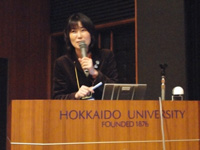JAXA Astronaut Activity Report, March 2011
Last Updated: May 2, 2011
This is JAXA's Japanese astronaut primary activity report for March 2011.
Astronaut Furukawa Trains for ISS Expedition Mission
Astronaut Furukawa, assigned as an International Space Station (ISS) Expedition 28/29 crew member, continues training for his upcoming mission aboard the ISS at NASA’s Johnson Space Center (JSC).
Furukawa reviewed medical hardware and equipment in the Human Research Facility (HRF) rack and other medical equipment on board the ISS. He also reviewed how to perform exercises using the Advanced Resistive Exercise Device (ARED) and the maintenance procedure for the Combined Operational Load Bearing External Resistance Treadmill (COLBERT).

Expedition 28/29 crew members participating in training on ISS crew activities during the space shuttle’s rendezvous/docking operations (Photo Credit: JAXA/NASA)
Furukawa, alongside NASA astronaut Michael Fossum and Russian cosmonaut Sergei Volkov, who will be his fellow crew members during the Expedition 28/29 mission, simulated ISS crew activities during the space shuttle’s rendezvous/docking operations according to a mission timeline. They simulated photographing the space shuttle’s heat shield, which ISS crew members perform while the space shuttle performs the R-bar Pitch Maneuver (RPM) below the ISS.
Furukawa also participated in a training session on the Space Station Remote Manipulator System (SSRMS). Using a virtual reality simulator, he simulated the removal of the Orbiter Boom Sensor System (OBSS) from the payload bay of the space shuttle docking with the ISS.

Furukawa (left) and NASA Astronaut Fossum (center) reviewing the operation procedures of the MARES (Photo Credit: JAXA/NASA)
In late March, Furukawa visited ESA’s European Astronaut Centre (EAC) in Germany to participate in training on science and system racks on board the Columbus laboratory. It was his last training session at ESA before his launch to the ISS. The training focused mainly on the Muscle Atrophy Research and Exercise System (MARES) rack. Furukawa learned the system overview, operation procedure, medical protocol, and maintenance procedure of the MARES.
Astronaut Candidate Training
Astronaut candidates Yui, Onishi and Kanai continued their astronaut candidate training at JSC and other training sites in the United States.
While continuing language lessons and flight training using a T-38 jet trainer, Yui participated in an SSRMS simulation exercise, Onishi completed his last Extravehicular Activity (EVA) training session in the astronaut candidate training program, and Kanai participated in ISS flight controller’s simulation training, playing the role of a crew member aboard the ISS.
Astronaut Wakata Participates in IAF 60th Anniversary Celebration Event

Wakata at a media briefing (Photo Credit: JAXA)
Astronaut Wakata visited the United Nations Educational, Scientific and Cultural Organization (UNESCO) headquarters in Paris to participate in the International Astronautical Federation (IAF) 60th Anniversary Celebration event and a media briefing.
At the beginning of the media briefing, Wakata discussed Japan’s contribution to the IAF, and mentioned the earthquake and tsunami disasters having occurred in the Tohoku and Kanto regions on March 11, extending condolences to the victims. He also mentioned JAXA’s satellite technologies, which demonstrated their usefulness and significance in the disaster management and monitoring during and after the catastrophic events.
Wakata received many questions from reporters from many different countries. When he was asked about the spaceflight experience he would most like to share with people on the ground, he answered “I would like to share the amazing views of Earth from space” and continued “When I saw Earth from space for the first time, I felt privileged to live on this beautiful planet, and also felt obliged to protect its precious environment and ecosystems”. He went on to mention the history and heritage of manned spaceflight, saying “I sincerely appreciate the endeavor and intrepid quests of Yuri Gagarin and many other pioneers of manned spaceflight. Human spaceflight activities today are built upon the activities of these great precursors”.
Astronaut Yamazaki Participates in Kibo Utilization Forum in Hokkaido

Yamazaki giving a lecture (Photo Credit: JAXA)
Astronaut Yamazaki participated in the Kibo Utilization Forum, Sapporo Seminar 2011 titled “Kibo’s Next Stage – Space Food Featuring Hokkaido’s Local Food,” held at Hokkaido University on March 4, 2011.
During the seminar, Yamazaki discussed the STS-131 mission, on which she flew, and gave a lecture on human spaceflight and food.
Yamazaki introduced some of the Japanese space foods that are jointly developed by JAXA and food companies in Japan. She explained that only a small amount of fresh vegetables and fruit are delivered to the ISS because of their perishable nature. She also related an episode of the preserved foods developed for a wintering party at the Showa Station (Antarctica), which she brought to her mission aboard the space shuttle.
At the end of the lecture, she discussed future space food, saying “When the direction of human spaceflight program is shifted from a low Earth orbit (LEO) to the Moon and Mars in future, the space food will also have to be changed. There would be different requirements for future space foods, such as a longer shelf-life and/or a space agriculture system.” She subsequently concluded her lecture, saying “We, as JAXA astronauts, look forward to having new Japanese space foods featuring food technologies in Hokkaido in the near future.”
During a panel discussion, Yamazaki and other panelists discussed whether Hokkaido’s food culture could be applied to Japanese space food development as part of the Kibo utilization public outreach activities.




